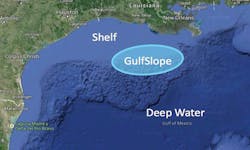Gulf of Mexico
Bruce Beaubouef • Houston
Lawsuits seek to halt Lease Sale 251
On July 12, the Bureau of Ocean Energy Management (BOEM) announced Lease Sale 251, in which it will offer approximately 78 million acres offshore Texas, Louisiana, Mississippi, Alabama, and Florida for oil and gas exploration and development. The region-wide lease sale scheduled for Aug. 15, 2018, includes all available unleased areas in federal waters of the Gulf of Mexico.
Lease Sale 251 will be the third offshore sale under the National Outer Continental Shelf (OCS) Oil and Gas Leasing Program for 2017-2022. Under this program, 10 region-wide lease sales are scheduled for the Gulf. Two Gulf lease sales will be held each year and include all available blocks in the combined Western, Central, and Eastern Gulf of Mexico Planning Areas. The lease sale will include approximately 14,622 unleased blocks in the Gulf’s Western, Central and Eastern planning areas in water depths ranging from nine to more than 11,115 ft (three to 3,400 m).
But just days after the announcement, three environmental groups filed lawsuits against the Interior Department in an attempt to halt the sale. The Gulf Restoration Network, the Sierra Club and the Center for Biological Diversity contend that the BOEM failed to adequately assess the potential environmental impact of the lease sale. The groups say that BOEM’s analysis relied on two safety regulations that the Interior Department is now proposing to relax, making the drilling even less safe for the environment.
The two regulations are overseen by the Interior’s Bureau of Safety and Environmental Enforcement (BSEE). The Well Control Rule and Production Safety System Rule govern the equipment and operations of oil and gas wells, from design to decommissioning, as well as the safety and pollution prevention devices for offshore oil and gas production.
The plaintiffs, who filed the lawsuit in a US District Court in Washington, D.C., are seeking to block the lease sale. The overall leasing plan would open 78 million acres for lease all at once. This practice will allow buyers to pick from the entire lot, or whatever was not sold in previous sales, during a semi-annual auction that will last until 2022. Previously, the agency auctioned off parcels block by block.
“The Gulf of Mexico has been offered for leases for years, but now there’s a free-for-all without adequate protection, and that’s problematic,” said Chris Eaton, an associate attorney for Earthjustice, which is filing the lawsuit on behalf of the plaintiffs. Eaton was quoted in several online reports.
The lawsuit describes at length the ostensible health and safety risks and purported climate change impacts that could come with more drilling. But, unlike other ongoing lawsuits that specifically challenge federal analyses of climate impacts for coal, oil, and gas leases, the latest lawsuit is not taking aim at BOEM’s climate assessments. But the Sierra Club and others ultimately decided to focus on other aspects of the environmental report instead.
“It comes down to what is your strongest legal claims. We don’t necessarily agree with whether they did (the climate analysis) correctly, but it’s not something we want to challenge considering there are so many other major flaws,” Eaton said.
The legal claims in the case will not be new to the court. Eaton cited a case, Native Village of Point Hope v. Sally Jewel, Secretary of the Interior, in which several indigenous communities in Alaska sued BOEM several years ago over an environmental assessment for an offshore oil and gas lease sale in the Chukchi Sea.
In 2014, the Ninth Circuit Court of Appeals reportedly agreed with the plaintiffs that BOEM underestimated the amount of oil that could be produced and did not adequately explain its calculation. An incorrect production estimate would also lead to inaccurate calculations for the likely environmental and climate impacts, such as oil spills, the appeals court said. BOEM prepared a new environmental analysis and reportedly conceded that the risk for oil spills was higher than originally anticipated if the leases were fully developed.
The federal waters in the Gulf of Mexico already has about 2,000 oil and gas platforms, covered under 2,600 active oil and gas leases, according to the lawsuit. “From 2011 through 2016, Interior’s records show more than four losses of well control per year on average in the Gulf. And Interior’s records show there is a fire offshore in the Gulf every three days on average,” the lawsuit contends.
GulfSlope announces drilling program
GulfSlope Energy, Inc., reports that the Rowan Ralph Coffman jackup rig is being towed to the Vermilion Area in South Addition block 378, as part of a drilling program in the Gulf of Mexico. The company says it plans to commence drilling operations at the Canoe Prospect by Aug. 1, pending final rig inspection and drilling approval from the Bureau of Ocean Management (BOEM).
GulfSlope Energy’s new drilling program is part of what it believes will be “a resurgence in industry interest for the shelf of the US Gulf of Mexico.” (Courtesy GulfSlope Energy)
Located in 325 ft of water, the Canoe exploration well is planned to test multiple Pleistocene age amplitudes that correlate to productive zones in nearby producing fields. Drilling operations are expected to take approximately 15 days to reach a measured depth of 6,249 ft. If successful, this above-salt test will be evaluated for development options ranging from subsea tiebacks to building a production platform.
Immediately following the drilling of the Canoe well, GulfSlope will mobilize the Ralph Coffman to drill the initial exploration well on the Tau prospect on Ship Shoal Area, in South Addition blocks 336/351. The Tau well is located in 305 ft of water and is planned to be drilled to a measured depth of 29,728 ft. The well targets multiple deep subsalt formations. The company’s exploration plan for Tau was recently approved by the BOEM and the company anticipates receiving the approved permit to drill in August.
GulfSlope is the operator of both wells with a 20% working interest. Delek GOM Investments LLC will have a 75% working interest and Texas South Energy Inc. will own a 5% working interest. Under the terms of its operating agreement, GulfSlope will pay 8% of the cost to drill the exploratory wells and 20% of the costs thereafter upon commercial discovery.
Talos brings Mt. Providence well online
Talos Energy Inc. has started production from the Mt. Providence well in Mississippi Canyon block 28 in the Gulf of Mexico, about 60 days ahead of schedule. Current gross production is 3,850 boe/d.
In a water depth of 1,850 ft (564 m), the well is tied into the existing Pompano Phase II subsea template located about 5 mi (8 km) from the Pompano platform.
The Mt. Providence well was drilled in January 2018 by Stone Energy Corp. after entering into, but before closing, the combination with Talos. •


